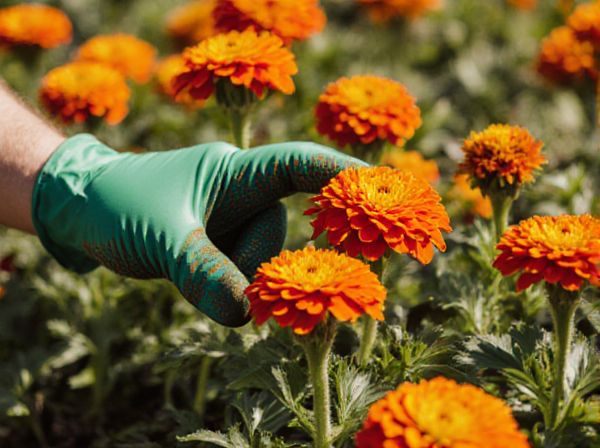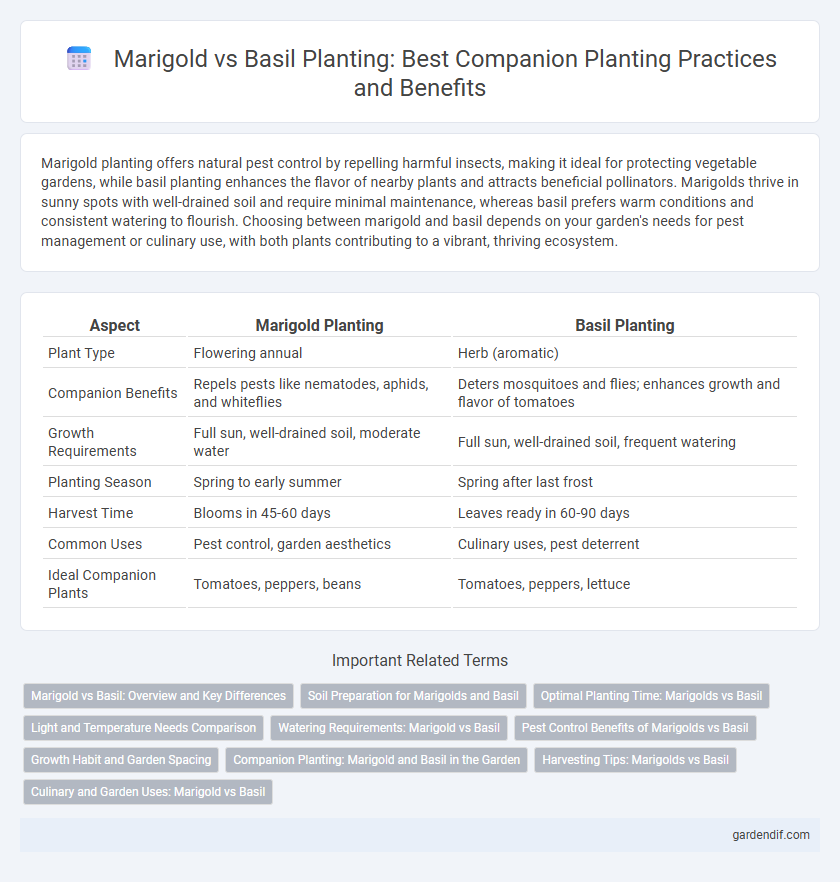
Marigold planting vs basil planting Illustration
Marigold planting offers natural pest control by repelling harmful insects, making it ideal for protecting vegetable gardens, while basil planting enhances the flavor of nearby plants and attracts beneficial pollinators. Marigolds thrive in sunny spots with well-drained soil and require minimal maintenance, whereas basil prefers warm conditions and consistent watering to flourish. Choosing between marigold and basil depends on your garden's needs for pest management or culinary use, with both plants contributing to a vibrant, thriving ecosystem.
Table of Comparison
| Aspect | Marigold Planting | Basil Planting |
|---|---|---|
| Plant Type | Flowering annual | Herb (aromatic) |
| Companion Benefits | Repels pests like nematodes, aphids, and whiteflies | Deters mosquitoes and flies; enhances growth and flavor of tomatoes |
| Growth Requirements | Full sun, well-drained soil, moderate water | Full sun, well-drained soil, frequent watering |
| Planting Season | Spring to early summer | Spring after last frost |
| Harvest Time | Blooms in 45-60 days | Leaves ready in 60-90 days |
| Common Uses | Pest control, garden aesthetics | Culinary uses, pest deterrent |
| Ideal Companion Plants | Tomatoes, peppers, beans | Tomatoes, peppers, lettuce |
Marigold vs Basil: Overview and Key Differences
Marigold and basil are popular companion plants with distinct benefits for garden ecosystems; marigolds are known for their pest-repelling properties, especially against nematodes, while basil enhances growth and flavor of nearby plants like tomatoes. Marigold thrives in full sun with well-drained soil, producing vibrant orange or yellow flowers, whereas basil prefers warm, sunny conditions and moist soil, yielding aromatic leaves used in culinary applications. Understanding the differences in their growth requirements and pest control benefits helps gardeners optimize plant health and maximize companion planting success.
Soil Preparation for Marigolds and Basil
Marigolds thrive in well-draining, moderately fertile soil with a pH between 6.0 and 7.0, benefiting from organic matter such as compost to enhance soil structure. Basil requires rich, moist, and well-drained soil with a slightly acidic to neutral pH of 6.0 to 7.5, favoring the addition of aged manure or fertilizer high in nitrogen to support vigorous growth. Proper soil preparation, including loosening the soil and ensuring adequate nutrient levels, is critical for both companion plants to maximize their growth and pest-repellent properties.
Optimal Planting Time: Marigolds vs Basil
Marigolds thrive when planted after the last frost in spring, ideally in soil temperatures above 70degF, ensuring robust growth and vibrant blooms. Basil requires consistently warm conditions with soil temperatures above 50degF, making late spring to early summer the optimal planting window. Timing the planting of marigold and basil to these specific temperature thresholds maximizes companion planting benefits, enhancing pest control and overall garden health.
Light and Temperature Needs Comparison
Marigolds thrive in full sun with temperatures ranging between 70-75degF (21-24degC), favoring warm conditions to bloom profusely. Basil also requires full sun but prefers slightly warmer temperatures around 75-85degF (24-29degC) to promote optimal leaf growth and aromatic qualities. Both plants need well-drained soil, but basil is more sensitive to cold temperatures below 50degF (10degC), while marigolds tolerate cooler nights without significant stress.
Watering Requirements: Marigold vs Basil
Marigold requires moderate watering, thriving best when the soil is kept evenly moist but not waterlogged, making it relatively drought-tolerant once established. Basil demands consistent moisture, needing frequent watering to maintain its tender leaves and prevent wilting, especially in hot weather. Careful attention to watering frequency for both plants ensures optimal growth and health, with marigolds benefiting from less frequent watering compared to the more moisture-dependent basil.
Pest Control Benefits of Marigolds vs Basil
Marigolds offer superior pest control benefits compared to basil by deterring nematodes, aphids, and whiteflies through natural compounds in their roots and foliage. Basil primarily repels mosquitoes and flies but is less effective against a broad spectrum of garden pests that marigolds target. Integrating marigolds in companion planting enhances pest management by reducing harmful insect populations and protecting adjacent vegetables more efficiently than basil.
Growth Habit and Garden Spacing
Marigold plants exhibit a bushy growth habit reaching 12 to 24 inches in height, requiring about 8 to 12 inches spacing for optimal air circulation. Basil grows upright or slightly spreading, typically 12 to 20 inches tall, and benefits from 10 to 12 inches spacing to prevent overcrowding. Proper garden spacing for both companions enhances airflow, reduces disease risk, and promotes healthy growth.
Companion Planting: Marigold and Basil in the Garden
Marigold and basil are excellent companion plants that enhance garden health by deterring pests and attracting beneficial insects. Marigolds release thiophenes that suppress nematodes and repel aphids, while basil emits aromatic oils that deter mosquitoes and whiteflies. Planting marigold and basil together in vegetable gardens promotes natural pest control and improves overall crop yields.
Harvesting Tips: Marigolds vs Basil
Harvesting marigolds is best done when the flowers are fully open to maximize their vibrant color and fragrance, typically in the morning after dew evaporates. Basil leaves should be harvested regularly by pinching off the top sets of leaves to encourage bushier growth and prevent flowering, which can reduce leaf flavor. Both plants benefit from frequent harvesting to prolong productivity and maintain plant health.
Culinary and Garden Uses: Marigold vs Basil
Marigold enhances garden ecosystems by repelling pests and attracting pollinators, while its petals add a mild, citrusy flavor to salads and soups. Basil, prized for its aromatic leaves, is a staple in culinary dishes like pesto, salads, and sauces, providing a sweet and peppery taste. Both plants contribute to garden health and culinary variety, with marigold primarily benefiting pest control and basil offering rich herbaceous flavors.
Marigold planting vs basil planting Infographic

 gardendif.com
gardendif.com